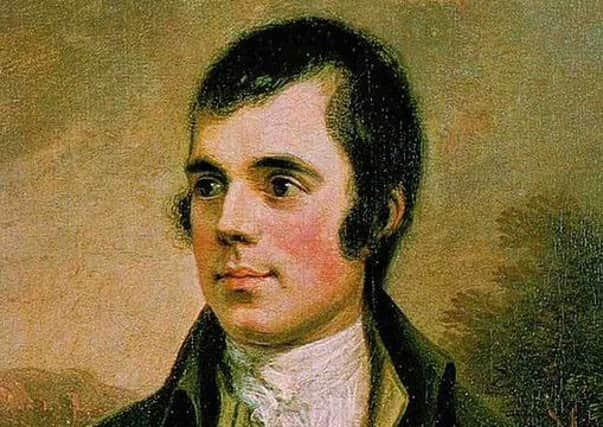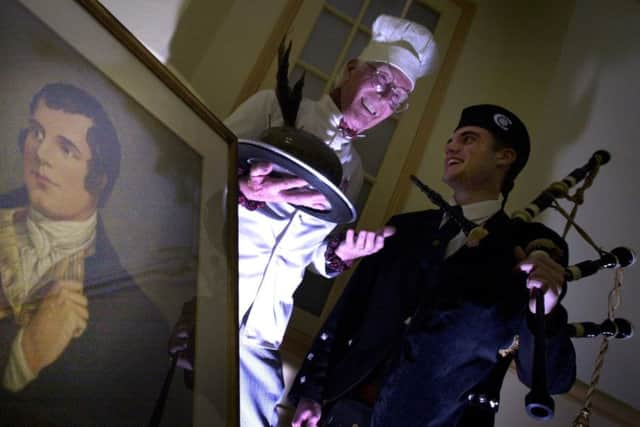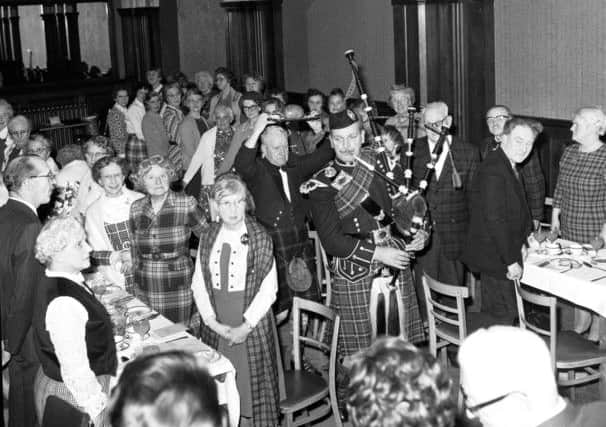Wha Hae, it's time to celebrate oor ain Rabbie Burns


Some may even attend an organised supper or ceilidh, where poetry will be recited, Scottish songs will be sung and a few wee drams consumed.
Every year on his birthday (January 25) we toast the life of one of the most celebrated figures in Scotland’s history – Rabbie Burns.
Advertisement
Hide AdAdvertisement
Hide AdIt has been 220 years since our national Bard died at the age of 37 but such is the contribution he made to Scottish literacy and culture, his legacy continues today.


This is why we toast his life with an annual celebration, a Burns Supper or Burns night, to mark his birthday.
This you may already know. But did you know where and when the first ever Burns supper was held?
It took place in 1801 in the village he was born, Alloway near Ayr, when friends gathered to mark the fifth anniversary of his death.
Advertisement
Hide AdAdvertisement
Hide AdIn fact, many of the traditions we now enjoy on January 25 came from that day when haggis was served as the main course, washed down with a whisky or two for the toasts!


The haggis was introduced at that meal using one of Burns’ most famous poems – the aptly titled Address to a Haggis.
And since those very early days, it has become a Scottish tradition to celebrate the country’s most well-loved poet.
But who was the man who went on to become a celebrated cultural icon, not only in Scotland but around the world?
Advertisement
Hide AdAdvertisement
Hide AdRabbie Burns, the eldest of seven children, was born in 1759 and grew up experiencing poverty and hardship, working on the family farm – where his title of the Ploughman Poet comes from.


He had very little schooling, receiving it mainly from his father at home, but his father knew how important it was to have an education. So at the age of 14 the young Burns was sent to Ayr to be taught by teacher John Murdoch, to help improve his grammar.
It is believed Rabbie showed a creative flair for writing from the start.
Burns first collection of poetry work, which became known as the Kilmarnock Edition, was published in 1786 and after this his writing career took off.
Advertisement
Hide AdAdvertisement
Hide AdHe struggled with physical labour working on the farm in Ayrshire and increasingly his focus turned to poetry, drink and women.


He began an affair with Jean Armour, who eventually became his wife, but difficulties in their on-off relationship nearly led him to flee the country with his lover Mary Campbell.
However, it was Mary’s death, coupled with the success of his first collection of works being published, that made him decide to stay in Scotland.
In his late twenties he relocated to Edinburgh where several affairs and illegitimate children followed. It was also a productive time in terms of his work.
Advertisement
Hide AdAdvertisement
Hide AdBut in just under two years, he was forced to look for a job as he had spent all the money he made from his poetry.
He secured a post as an excise officer in Dumfries and rekindled his relationship with Jean Armour. They had a total of nine children and married in 1788.
But the struggles in his early life, along with the hard toil in his new job, took its toll on Burns. He was physically worn out and had a recurring heart condition.
He eventually died from endocarditis, an infection of the heart’s valves or inner lining, on July 21, 1796 – the same day his son Maxwell was born.
Advertisement
Hide AdAdvertisement
Hide AdThroughout his life he produced an extensive collection of work, writing over 260 poems and penning over 300 songs, taking his inspiration from the stunning Scottish countryside, his birthplace as well as his relationships and life experiences.
There are many to choose from but arguably his most notable works are Auld Lang Syne, To a Mouse, A Man’s a Man for A’That, Scots Wha Hae, Ae Fond Kiss, Tam O’Shanter and A Red, Red Rose.
His work has continued to inspire writers, musicians and popular culture through the years.
Burns’ work has been mentioned in films including It’s A Wonderful Life and When Harry Met Sally. A Man’s a Man was also chosen for the Scottish Parliament opening in 1999.
Advertisement
Hide AdAdvertisement
Hide AdPopular around the world, it is in his homeland where the biggest Burns celebrations are held every January.
Burns Night – the essential ingredients for a successful supper
A successful Burns Supper has several traditional ingredients.
A piper plays Scottish music to welcome in the guests who are all seated.
Advertisement
Hide AdAdvertisement
Hide AdA short prayer, The Selkirk Grace, is read before the meal. Guests then stand for the Piping in the Haggis. The haggis is carried in on a silver platter by ‘Poosie Nancy’ (a character who features in Burns poetry and is usually dressed as a waitress wearing a mob cap) with a procession featuring the chef, the piper and the person who will address it.
This is followed by the Address to the Haggis. The chosen reader recites To A Haggis and on cue, the haggis is cut. At the end of the recital, the reader is applauded. There is then a toast to the haggis before the meal is served, usually consisting of soup, then haggis, neeps and tatties and Clootie dumpling or Scottish trifle.
This is followed by the Immortal Memory when the key speaker talks about the life of Rabbie Burns. The highlight of the evening is the Toast to the Lassies which is a toast to the role of women in the world today and then there is the Reply to the Toast to the Lassies with the women having their chance to respond. In between, there is entertainment consisting of Burns poetry readings and songs, followed by a vote of thanks, and the night ends with a rendition of Auld Lang Syne.
Burns celebrated across the globe
There are not many Scots who have as much international recognition as Rabbie Burns.
Advertisement
Hide AdAdvertisement
Hide AdThe national poet has more statues dedicated to him around the world than any other non-religious figure, with the exception of Queen Victoria and Christopher Columbus. Canada and Australia each have seven statues, New Zealand has four and the USA boasts 14 – including one in Central Park, New York.
Rabbie also appears at the Sorbonne in Paris. He is commem-orated in far flung places, with celebrations taking place from Tanzania to Delhi, St Petersburg to Dhaka. Robert Burns is also popular in China – where Scottish societies from both Beijing and Shanghai host celebrations. There are Burns Clubs all over the globe which hold suppers every year including: the Hong Kong St Andrews Society, the St Andrews Society of Montreal in Canada, the Abu Dhabi St Andrews Society and the Caledonian Society of Hawaii. The New York Caledonian Club, founded in 1856, holds one of the most extravagant black tie Burns Suppers with this year’s tickets ranging from $150 to $200 for music, dancing and a silent auction.